Newtonian Gravity
Law of Gravitation by Newton
The gravitational force between two masses separated by a distance is directly proportional to the product of their masses and inversely proportional to the square of the distance.
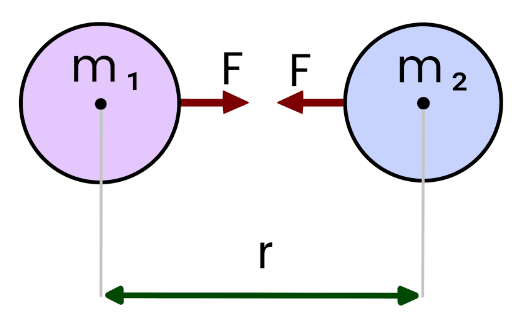
The force of attraction (F) between two masses (m1 and m2) separated by a distance of r, can be expressed as directly proportional to the product of their masses (m1 * m2) and inversely proportional to the square of the distance (r^2) between their centers of mass. Mathematically, this can be represented as:

Where G is the Universal Gravitational Constant, a fundamental constant of nature that has a value of approximately 6.6743 x 10-11 N*(m/kg)2

G = 6.67 x 10-11 N m2 kg-2
The weakness of the gravitational force can be demonstrated by examining the case of two 1 kg masses separated by a distance of 1 meter:

This demonstrates that for everyday objects, the gravitational force is so negligible that it can be considered almost irrelevant.
Variation of ‘g‘ with distance from the Earth’s center
In order to comprehend this concept, it is necessary to recall that ‘g’ denotes the acceleration caused by gravity, with a value of 9.8 m/s2, typically applicable to the Earth’s surface. Weight, represented as W, is the gravitational force exerted by the Earth on an object. For an object with mass ‘m’, its weight can be calculated using the following equation:
W = mg
The mathematical analysis relies on two presumptions:
1. The acceleration due to gravity, g, retains the same value at a specific distance from a mass, irrespective of whether the mass is concentrated at the center or distributed in the shape of a spherical shell.
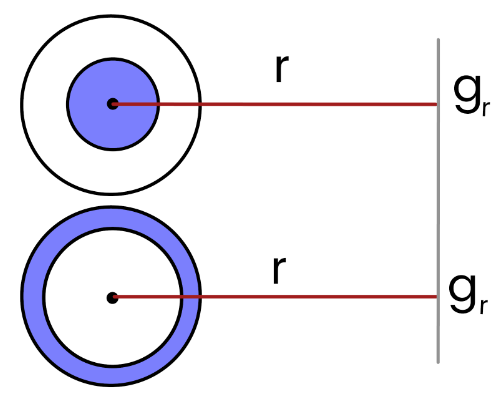
2. Within a spherical shell, the value of g is zero throughout its entirety.
Note that both the central mass and the spherical shell possess uniform density. Let us first examine the scenario where a mass m is situated on the surface of the Earth. The gravitational pull between the mass and the Earth is equivalent to the weight of the object, represented as W. This value is equivalent to the force, F, between the object and the Earth, in accordance with Newton’s Law.
W = F

(i
Where ME is the mass of the Earth, rE its radius.
Now let us consider the value of g at a distance r from the Earth.
case where r > rE
If this new value is gr , then by similarity with equation (i,
(ii
Dividing equation (ii by equation (i,
(iii
the case where r < rE
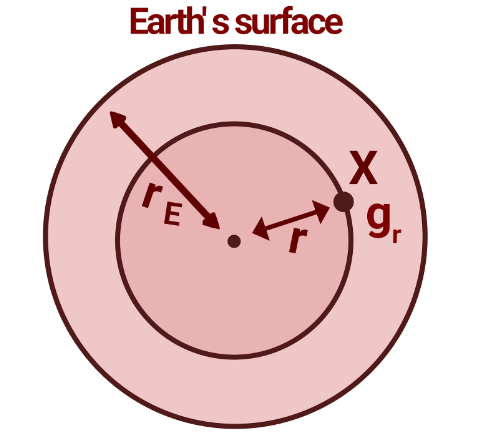
Within the illustration, point X is positioned inside the Earth, precisely ‘r’ distance away from the Earth’s center. Based on our preliminary suppositions, the magnitude of g times r is an outcome of the gravitational pull exerted by a sphere with a radius of r. If we denote the mass of the sphere as MS, then upon comparison with the equation (i ,

(iv
Note that the presence of material, in the form of a shell, positioned above point X, does not impact the value of gr. Let us postulate that the masses possess uniform density, denoted as ρ (rho). Recalling that m is equivalent to ρV, the mass of the internal sphere, represented as MS, and the mass of the Earth, represented as ME, can be calculated as follows:


dividing the first equation by the second,

Substituting for MS from equation (iv ,


recalling that

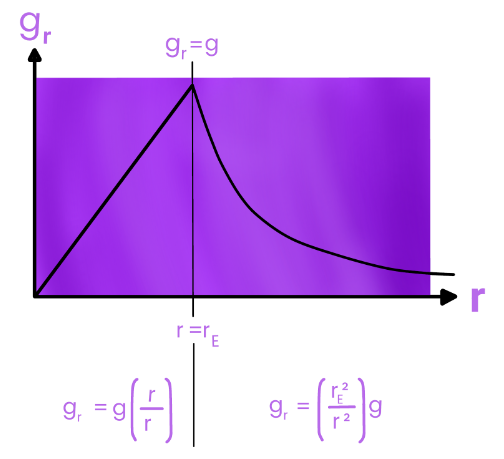
NB gr = g when r = rE
Summary
Hence, for locations within the Earth, the value of gr is directly proportional to r. As a consequence, the graph is a linear function passing through the origin. However, for locations situated outside the Earth, gr adheres to a function that closely resembles y = x-2. In this scenario, the value of x continuously decreases, eventually approaching zero when it reaches infinity.

Fields
In this section and those to follow, we explore three distinct types of fields that exist in a region of space and influence objects with specific properties. These are as follows:
- Gravitational fields which impact any object possessing mass
- Electric fields which affect any object with a charge
- Magnetic fields which influence permanent magnets and electric currents.
While these three field types share several characteristics, there are also some noteworthy distinctions between them.
Across all three field types, several fundamental principles and definitions apply.
It is important to note that even radiant energy, such as light, possesses mass and is therefore subject to the influence of gravitational fields.
Gravitational fields
Newton observed that objects with mass exert an attractive force on one another, despite the fact that this may not be immediately noticeable in everyday situations. For example, placing two objects in close proximity on a desktop does not cause them to immediately move closer together, as the gravitational force between them is relatively weak. Additionally, this force is significantly less than the opposing frictional forces that impede their movement.
The gravitational force of attraction between two objects only has a noticeable impact on their motion when at least one of the objects is extremely massive. This is why we are aware of the gravitational force that pulls us and other objects toward the Earth; the Earth itself is incredibly massive, with a mass of approximately:
about 6 × 1024 kg.
The direction of the force acting on a mass within the Earth’s gravitational field is depicted by the lines in the diagram.

The diagram illustrates the following:
- The Earth’s gravitational force is always attractive, meaning objects are pulled towards it
- The direction of the gravitational pull is towards the center of the Earth
- The gravitational field lines are radial, which means they spread out evenly from the center of the Earth and become less concentrated as distance from the Earth increases
The position of an object in a gravitational field affects the force exerted on it. The force is smaller where the field lines are less concentrated. The force can be calculated if the gravitational field strength at a point is known.

The direction of the gravitational field strength is towards the object creating the field, making it a vector quantity.To avoid losing marks, it is important to use the correct value for g provided in the formula sheet instead of using 10ms–2, as g = 9.81ms–2.
Universal gravitation
Newton’s law of universal gravitation states that the gravitational attractive force between any two masses:
- is directly proportional to the product of the masses
- is inversely proportional to the square of the distance between their centers.

One example of a point mass is an object with a radial field, such as the Earth.
The Earth, despite its size, can be considered a point mass on a universal scale. At its centre, the gravitational field strength is zero as the attractive forces are symmetrical in all directions. As distance from the Earth’s surface increases, the gravitational force on an object decreases. The force between two objects follows an inverse square law with distance measured from the Earth’s centre. Doubling the distance from the centre of the Earth reduces the force to a quarter of its original value. The diagram illustrates the variation of force with distance from the Earth’s centre.
It’s important to remember that when two objects interact gravitationally, the forces acting on them are equal in size but opposite in direction.
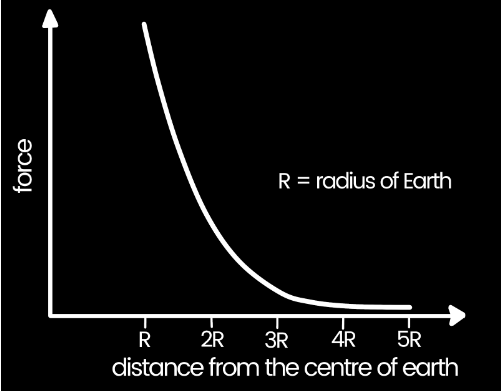
g and G
The law of gravitation formulated by Newton provides a means of calculating the force between any two objects, as well as determining the strength of the gravitational field produced by a spherical mass like the Sun or Earth.

In some cases, a negative sign is incorporated into the right-hand side of the equation, reflecting the convention that attractive forces are assigned negative values, while repulsive forces are assigned positive ones.
Since gravitational field strength is defined as force per unit mass, it can be deduced that the field strength at a given point (represented by g) is related to the mass of the Earth through the following expression:

The value of gravitational field strength, denoted as g, is a property of any point within a gravitational field, regardless of whether there is a mass present at that point. Similar to gravitational force, the value of g follows an inverse square law beyond the surface of the Earth.
Since the inverse square law applies to distances measured from the center of the Earth, there is little change in g near the Earth’s surface. Even at a height of 10,000 m, which is typical for aircraft flying, the change in distance from the center of the Earth is negligible, resulting in no noticeable change in g. The Earth’s radius is approximately 6.4 × 106 m, so one would need to go much higher than aircraft-flying height to observe a 1% change in g.
The same symbol, g, is used to represent:
- The strength of the gravitational field at any point is called gravitational field strength
- Free-fall acceleration is the acceleration of an object in the gravitational field of another object
Gravitational field strength and free-fall acceleration refer to the same physical quantity. Gravitational field strength, denoted by g, represents the force per unit mass, which is given by the formula g = F/m.The free-fall acceleration, denoted by g as well, is also equivalent to the gravitational force per unit mass. This can be derived from Newton’s second law, and the unit for free-fall acceleration is meters per second squared (m/s2), which is the same as the unit for gravitational field strength (N/kg).
Newtonian gravity is a fundamental concept in physics that explains how objects with mass attract each other. It is based on Newton’s laws of motion and is used to describe the force of gravity between two objects.
The laws of motion are a set of fundamental principles that describe how objects move. They were first described by Sir Isaac Newton and are a crucial part of understanding Newtonian gravity. The three laws are: 1) an object at rest tends to stay at rest, and an object in motion tends to stay in motion, 2) the acceleration of an object is directly proportional to the force applied to it, and 3) for every action, there is an equal and opposite reaction.
The equation for Newtonian gravity is F = G(m1m2/r^2), where F is the force of gravity, G is the gravitational constant, m1 and m2 are the masses of the two objects, and r is the distance between them.
Gravitational force is the force of attraction between two objects with mass. It is proportional to the mass of the objects and the distance between them.
The force of gravity between two objects decreases as the distance between them increases. This is known as the inverse square law.
Newtonian gravity is responsible for the orbital motion of planets around the sun and other celestial bodies. The force of gravity between the two objects creates a centripetal force that keeps them in orbit.
Escape velocity is the minimum velocity required for an object to escape the gravitational pull of another object. It is determined by the mass of the object and the distance between them.
The force of gravity between two objects is directly proportional to the mass of each object. Therefore, the greater the mass of an object, the greater the force of gravity it exerts.
Newtonian gravity is a classical theory that describes the force of gravity as a result of the interaction between two objects with mass. Einstein’s theory of general relativity is a more advanced theory that describes gravity as a curvature of spacetime caused by the presence of mass and energy.
Newtonian gravity is used in many real-world applications, such as satellite communication, GPS systems, and space exploration. It is also used in fields like engineering and architecture to calculate the strength and stability of structures.





Still got a question? Leave a comment
Leave a comment